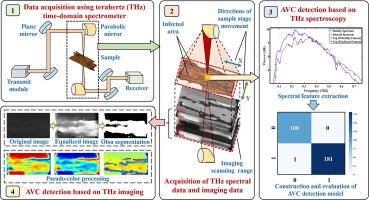太赫兹光谱和成像技术用于苹果溃疡病检测的可行性和潜力:初步调查
IF 4.3
2区 化学
Q1 SPECTROSCOPY
Spectrochimica Acta Part A: Molecular and Biomolecular Spectroscopy
Pub Date : 2024-10-22
DOI:10.1016/j.saa.2024.125308
引用次数: 0
摘要
苹果腐烂病(AVC)由苹果疫霉菌(Ascomycete Valsa mali)引起,严重影响苹果果实的产量和质量。苹果蠹蛾无症状的潜伏特性使得在早期感染阶段发现苹果蠹蛾非常困难。苹果蠹蛾的病原菌丝感染苹果树皮伤口后,会扩展并定植于韧皮部组织。同时,菌丝释放的各种酶和有毒物质会导致纤维素和木质素分解,并在树皮组织中产生有毒的次级代谢产物。然而,从树皮的外观上是看不到 AVC 的这些早期症状的。幸运的是,太赫兹光谱成像(ThzSI)技术具有穿透性和指纹识别的优势,有望检测出真菌感染的隐蔽或轻微症状。本研究是对感染早期 AVC 的太赫兹频域光谱的初步研究。研究人员准备了健康和感染两周的苹果树枝条,用于捕捉太赫兹频域光谱图像,并分别采用多元散射校正(MSC)、萨维茨基-戈莱卷积平滑(SG)和标准正态变异(SNV)对光谱数据进行预处理,以去除数据噪声,提高数据质量。采用主成分分析法(PCA)、竞争性自适应加权采样法(CARS)和随机蛙法(RFROG)提取光谱特征带,以消除冗余数据并提高计算效率。根据光谱特征建立了机器学习模型,以检测早期感染阶段的 AVC,其中 11 个模型表现最佳,F1 分数为 99.72%。为了进一步探索空间光谱中的疾病信息,研究人员利用太赫兹成像技术获取了成像数据。在成像数据的基础上,采用伪彩色成像、直方图均衡化和大津分割技术,对苹果树皮的早期感染区域进行可视化处理。此外,还利用从太赫兹光谱图像中提取的直方图特征(HF)、形状特征(SF)和局部二值模式(LBP)建立了 SVM、RF 和 KNN 模型。其中,HF-SF-KNN 和 HF-SF-LBP-KNN 的性能最佳,F1 分数达到 98.82%。本研究提出了太赫兹光谱和成像技术在早期 AVC 检测中的初步应用,并证明了其可行性。此外,它还提供了一种检测 AVC 的新方法,拓展了 ThzSI 技术在果园树木病害检测中的应用,为进一步的研究奠定了基础。本文章由计算机程序翻译,如有差异,请以英文原文为准。

Feasibility and potential of terahertz spectral and imaging technology for Apple Valsa canker detection: A preliminary investigation
Apple Valsa canker (AVC) caused by the Ascomycete Valsa mali, seriously constrains the production and quality of apple fruits. The symptomless incubation characteristics of Valsa mali make it highly challenging to detect AVC at an early infection stage. After infecting the wound of apple bark, the pathogenic hyphae of AVC will expand and colonize the phloem tissue. Meanwhile, various enzymes and toxic substances released by hyphae cause the decomposition of cellulose and lignin, and the generation of poisonous secondary metabolites in bark tissue. However, these early symptoms of AVC are invisible from the bark’s appearance. Fortunately, Terahertz Spectral Imaging (ThzSI) technology with the advantage of penetrating, and fingerprinting is promising for detecting hidden or slight symptoms of the fungal infection. This study is a preliminary investigation of terahertz frequency-domain spectra for AVC in the early stage of infection. Healthy and two-week-infected apple tree branches were prepared for capturing ThzS images, and the spectral data were preprocessed by Multivariate scattering correction (MSC), Savitzky-Golay convolution smoothing (SG), and standard normal variate (SNV) respectively to remove data noise and improve data quality. Principal component analysis (PCA), competitive adaptive reweighted sampling (CARS), and random frog (RFROG) were employed to extract the spectral feature bands to eliminate redundant data and improve computational efficiency. Machine learning models were established based on the spectral features to detect AVC at an early infection stage, where 11 of them exhibited the best performance with F1-score of 99.72%. To further explore disease information in spatial spectra, imaging data were acquired using terahertz imaging technology. Based on imaging data, pseudo-color imaging, histogram equalization, and Otsu segmentation were employed to visualize early infection areas in apple barks. Furthermore, histogram feature (HF), shape feature (SF), and local binary pattern (LBP) extracted from terahertz spectral images were utilized to establish the SVM, RF, and KNN models. HF-SF-KNN and HF-SF-LBP-KNN with the best performance achieved F1-score of 98.82%. This study presents a preliminary application of terahertz spectral and imaging technology for early-stage AVC detection and demonstrates its feasibility. Additionally, it provides a new way to detect AVC, which expands the application of ThzSI technology in tree disease detection in orchards and lays the foundation for further research.
求助全文
通过发布文献求助,成功后即可免费获取论文全文。
去求助
来源期刊
CiteScore
8.40
自引率
11.40%
发文量
1364
审稿时长
40 days
期刊介绍:
Spectrochimica Acta, Part A: Molecular and Biomolecular Spectroscopy (SAA) is an interdisciplinary journal which spans from basic to applied aspects of optical spectroscopy in chemistry, medicine, biology, and materials science.
The journal publishes original scientific papers that feature high-quality spectroscopic data and analysis. From the broad range of optical spectroscopies, the emphasis is on electronic, vibrational or rotational spectra of molecules, rather than on spectroscopy based on magnetic moments.
Criteria for publication in SAA are novelty, uniqueness, and outstanding quality. Routine applications of spectroscopic techniques and computational methods are not appropriate.
Topics of particular interest of Spectrochimica Acta Part A include, but are not limited to:
Spectroscopy and dynamics of bioanalytical, biomedical, environmental, and atmospheric sciences,
Novel experimental techniques or instrumentation for molecular spectroscopy,
Novel theoretical and computational methods,
Novel applications in photochemistry and photobiology,
Novel interpretational approaches as well as advances in data analysis based on electronic or vibrational spectroscopy.

 求助内容:
求助内容: 应助结果提醒方式:
应助结果提醒方式:


